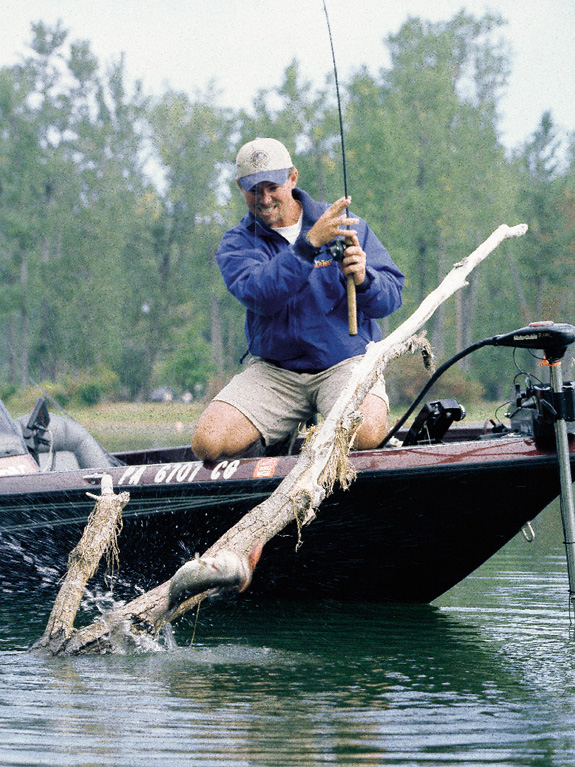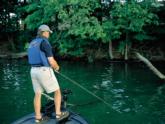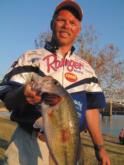Gnarly cranking

Keep the plastics in your pocket, it’s time to start cranking
It looks like a nightmare for a treble hook – twisted stumps, stickups, deadfalls and water so shallow that a diving lip is sure to dig a furrow. It brings new meaning to the expression “knock on wood” because you’ll need all the luck you can muster just to avoid getting snagged.
Or is it all luck? Is it possible to select the right tool – in this case a specially designed crankbait – apply the correct retrieve and bring that lure safely back to the boat time after time with bass in tow?
It’s not only possible; it’s necessary if you want to be successful on the professional tournament trail. Just ask these competitive anglers.
Bill McDonald of Indianapolis has been fishing FLW Outdoors tournaments for years, getting his start with in the Wal-Mart Bass Fishing League and then joining the ranks of the EverStart Series. He has enjoyed sufficient success along the way and is poised to fish the Wal-Mart FLW Tour.
McDonald is basically a shallow-water angler. “For the most part, I fish water 6 foot or less the entire season. During the summer, I fish a lot of water shallower than where bass spawned, targeting depths of 1 to 2 feet. I head to the larger bays and fish the real shallow flats that most people do not mess with.”
Dave Lefebre had been blowing by the competition in his home state of Pennsylvania before finally jumping into FLW Outdoors events in 2001. During his inaugural season in the Wal-Mart BFL, his talent was rewarded with respectable finishes and a strong showing in the overall standings. Although he considers himself a versatile fisherman who is comfortable either shallow or deep, it is his shallow water presentations that really shine.
Besides a love for shallow-water bass fishing, what do these two anglers have in common? They depend on crankbaits to fish cover that most anglers would only tackle with a spinnerbait or weedless soft plastic lure.
“I’ve always caught a portion of my bass from shallow cover,” Lefebre explains. “But recently, my percentage of shallow-cover bass has gone up since I began using crankbaits in places where other anglers would never throw them. Crankbaits trigger strikes that other types of lures do not.”
Certainly a flipping jig or Texas-rigged plastic is appropriate at some times of the year. But jig or worm fishing is slow and time-consuming, particularly during the summer and early fall when bass are willing to attack faster-moving baits. And there are also instances when vertical-fall baits like jigs simply do not draw the attention of bass – sometimes it has to be the faster-pace, erratic horizontal movement of a crankbait.
But not just any crankbait will get the job done, according to Lefebre. “Generally, for shallow cover, I look for a large body bait with a small lip and wide wobble. Many of the better ones have a square-like bill. The Big O, Wiggle Wart and One Minus all do a fairly good job of coming through cover. But the one that outshines them all is the Timber Tiger Depth-Controlled series, which effectively covers the 1- to 8-foot range.”
Lefebre attributes the Tiger’s unique design features as the reason why it works so well. The roller lip, wide at the front with a rounded ridge, helps the bait roll over roots and branches. The flat head also helps back up the crankbait when it contacts cover. Even those funny-looking fins on the sides called Timber Guards deflect snags by pushing the bait away when it contacts hard surfaces, which is especially critical when the bait rolls on its side to clear branches. With all of these features, Lefebre says, “The Timber Tiger has great crankbait action at any retrieve speed.”
McDonald says he modeled his crankbait approach after Gary Dees, a Cincinnati lure-maker with a reputation as one of the best shallow-water crankers on the Ohio River. Dees markets a handmade crankbait called the D-Bait, which McDonald considers one of the best tools for shallow-water cranking.
“These crankbaits have that hunting action, which means the bait will change direction for a split second as it deflects off a limb and then come back to true. A good one will move left to right as you reel, without rolling over, and always returns to the normal straight-line retrieve. This change in direction triggers bass to strike.”
McDonald backs up the shallow-running D-Bait with selections from the Strike King crankbait line, including the 4S and 1XS. “These baits cover the shallower depths I’m targeting, have great action and, with the specially designed lips, deflect cover without constantly hanging up.”
“Dees taught me a lot about crankbait fishing,” McDonald stresses. “To watch him fish a crankbait is like watching someone fish a worm. I’ve watched him throw a crankbait into some frightening places, yet he always managed to work it back out. That is the approach I have adopted.”
McDonald doesn’t hurry a retrieve when bringing a crankbait through cover. He winds some line, bumps something and pauses to let the crankbait float off. Using the rod tip, he gingerly pulls the bait to check resistance then begins cranking again. Crawling is a better description than cranking. Most strikes come when the crankbait hits an object and darts to the side, or when the retrieve is first initiated after a pause.
“I love the feeling when the crankbait goes sideways on a limb and wallows around the branches,” McDonald says. “When you get a strike in a situation like that, it is violent. The bass is trying to kill the bait in the thick stuff before it can escape.”
In shallow water, McDonald sees everything as a potential bass-holding target. Polarized sunglasses are one of his must-have accessories, especially in dingy water. “Everyone can see the objects that protrude above the water’s surface – laydowns, stumps, sticks and rocks. Of course these objects receive casts from anyone passing by,” he says. “But a critical piece of submerged cover may be visible as a slight shadow or color change in dirty water. If I can see a dark spot on a flat – and this is where sunglasses come in – it’s probably going to hold a bass. If you can get to it, it is worth fishing.”
Another piece of the shallow puzzle involves a very slight depth change on a flat. These mini breaklines typically indicate an old drainage ditch or seepage. Everyone knows about defined creek channel lips and will seek them out, but McDonald searches for the almost insignificant drops. In shallow water, little things can translate into big bass.
“Ditches are rarely marked on a map, and so I spend hours on the trolling motor during practice watching the depth finder to find these key sites on big flats,” McDonald says. “If there is the least bit of cover near a ditch, I’m ensured of catching bass.”
McDonald makes repeated casts to cover so the crankbait comes from every conceivable angle. He may throw four or five times to the same stump to touch all the bases.
“Too many beginning anglers believe bass are on the shady side of shallow cover,” he says. “At times they are, and if the pattern holds true, it makes for a great day of fishing. But more often than not, you cannot depend on it, so I fish all sides including the direct sunlight area. If you don’t make those extra casts with a crankbait, you are going to miss bites.”
Lefebre’s viewpoint
“When I’m cranking, I am looking for that reflex bite,” Lefebre says. “I fish fast, adjusting retrieves so the lure bumps into things. I’m not really concerned whether the crankbait is behaving like a prey fish or crayfish – nor are the bass. Bass strike it simply out of reaction. The more contact there is with cover that makes the bait careen off to the side, the better my chances of drawing a strike. I use a lot of body English on casts to maneuver a crankbait into position.”
Pinpoint casting is very important to Lefebre. He believes that 95 percent of the snags anglers encounter with crankbaits in shallow water result from poor cast placement. If the crankbait does not land in the water but hangs on a branch instead, or if it lands on a small mat of floating vegetation clinging to wood cover, the cast is dead before it begins.
“As long as I land the crankbait in a clear pocket of water, I’m confident about making a clean retrieve,” Lefebre says. “The retrieve I normally use is medium-slow and fairly steady. The Timber Tiger will walk through most situations with a steady retrieve. Sometimes I have to pause to get a little different angle on a limb by shifting my rod angle. And when the line lays across a limb out of the water, I stop winding just as the bait hangs in mid-air about to touch the dry limb. Then I give it a little pop to make it flip over the object.”
In shallow cover, Lefebre is not as concerned with bumping bottom with a crankbait as deepwater anglers are. He does, however, adjust his rod angle to make the bait run deeper or shallower. “In the shallower part of the cast, I keep the rod tip up so it will only dive a foot instead of its running depth,” he says. “As the retrieve moves closer to the boat and into deeper water, I begin dropping the rod tip to let the bait run to its maximum depth.”
When searching for fish in practice, Lefebre keeps two rods rigged with crankbaits at all times. Both lines have No. 2 Duo-Lok snaps for quick changes of lures. One rod is usually rigged with a DC8 that has a running depth of 6 or 7 feet on heavy line. The bait on the second rod is routinely switched between a DC2 and DC4. “The one I select, either the 2 or 4, depends on the depth of the cover. In open water areas between visible cover, I throw the DC8, which is my bird-dog bait to find submerged stumps, rocks, etc.”
Docks are popular shallow-water targets for Lefebre, and even there, he employs a crankbait. His best success in a Wal-Mart BFL event this past season was at the Potomac River tournament. There he skipped a DC1 under docks. “The fat little DC1 skips amazingly well, especially if you remove the front treble hook,” he says. “My back-up spots at the Potomac were clean lily pads – no grass mixed in – where I cranked the DC2 though openings in the stalks.”
Mistake not to crank
Lefebre and McDonald have proven to their satisfaction that cranking the shallow gnarly cover is effective in the spring, summer and fall.
McDonald adds: “I’m not saying a crankbait is always the best bait, but last year in a BFL tournament, I was pitching a jig to tangled cover because I felt it was the better bait given the time of year. My partner in the back of the boat, however, was throwing a crankbait. After hitting one particular piece of cover with several pitches of the jig, my partner ran a crankbait past it. He nailed a 6-pound, 9-ounce largemouth. I went on to win the event, but that big fish was one I really wanted since it turned out to be the lunker of the tournament.”
That was a lesson about keeping an open mind and a reminder just how effective a reaction bait can be when bass in heavy cover have been overworked with jigs and worms.
McDonald believes, in most instances, crankbaits imitate prey fish. Therefore he follows a “match-the-hatch” philosophy.
“Shad is the dominant baitfish in the waters I fish most often, so I guess 90 percent of the time I throw a shad-imitating bait – either a shad/gray back or shad/black back,” he says. “Pearl and bone are also good generic prey fish colors for crankbaits. In very dingy water, however, I will switch to chartreuse-colored baits.”
Lefebre takes a different approach. He does not believe that a crankbait necessarily represents a particular kind of prey – be it minnow, crayfish or something else. He places crankbait patterns into one of three basic groups: natural baitfish (shad, pearl, chrome); natural crayfish (greens and browns with hints of orange and red); and unnatural colors (chartreuse, red, etc.)
“When fishing unfamiliar waters, I alternate between the three color groups until I figure out what the bass favor,” Lefebre explains. “On lakes and rivers that I fish often, I’ll have specific colors that have proven themselves time and time again during specific seasons. Color is not a religion to me; I experiment a lot. If I could only have one color, however, I guess it would be shad.”


